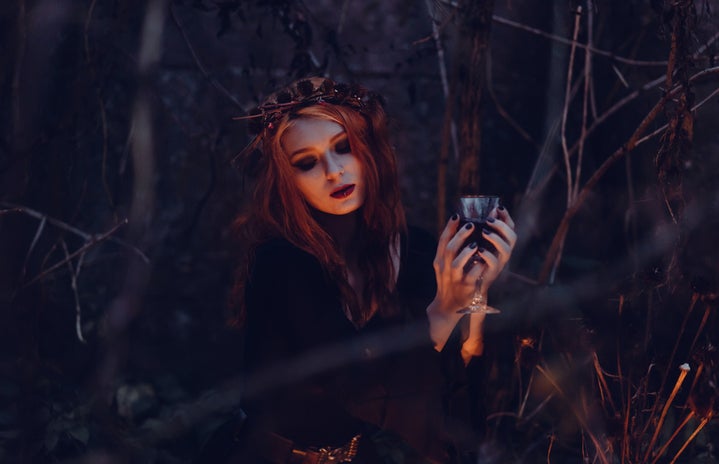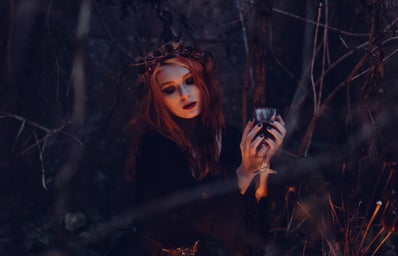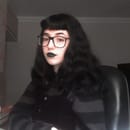Tiktok is responsible for helping all kinds of people earn the representation they deserve and that, in many times, is not given in the traditional media. Alternative people are more than included in this category and this hypothesis can be proved by our well known e-girls and e-boys. Even if it’s not the ideal yet, now it’s possible to find some diversity through them in the platform. However, they are not just helping to represent different genders, bodies and colors of people with the same aesthetic as them. Rubia Del Vecchio, better known as Nosferotika, originally for her blog’s name, believes it also helps her community, the Goth subculture: “I like to say that e-girls saved the world, because they give visibility to alternative people that didn’t exist ten years ago”.
Rubia is a Brazilian Goth digital creator. Her work consists in producing beauty and fashion-related content for many platforms, such as Youtube, Instagram and Tiktok. Through her social media, she not only talks about the subculture itself, but also promotes and contributes to the diversity in it and tries to give all sorts of alternative creators – but mostly women – voice and visibility. If you aren’t so familiar with the Goth scene and its lack of representativeness, keep reading to find out all about it through the eyes of a Goth woman herself.
- A quick view on the Goth subculture
-
The Goth subculture is a social movement that began in the United Kingdom between the late 70s and the early 80s. It was inspired by another movement, called “punk”, which was originated by the worker’s class, people who started rebelling against capitalism due to tiredness of oppression and exploitation. While punks react to the political world very actively and riotously, the goths came as a reply to this scenery.
According to Rubia, “the Goth is the apathetic part of this response to capitalism. At first, it agreed with the punk’s ideological reasons, but then it realised that ‘life sucks, nothing is going to change, everything will continue to be horrible’”. However, she states that this scene went through a lot of changes as time passed by, resulting nowadays into something more vast than its roots. It focuses on embracing what’s considered by society to be different, in order to fight against judgments and prejudice. “The most important aspect is that you don’t have a conservative mindset”, she says.
To Rubia, the first thing anyone needs to be considered Goth is enjoy the music. “Other aspects, like enjoying the literature, using the visual and all that stuff, is secondary. You need to identify with the music to say you’re a goth”. She also explains what distinguishes this genre from others: “What originated it was the post-punk. This style is slower, has a strong presence of the bass, with thicker and slower vocals”. Some famous examples of Goth bands are Bauhaus, Joy Division, Sisters of Mercy and Siouxsie and the Banshees.
Within all the symbolism behind this subculture, one that frequently catches most attention of those who are not very familiar with the community is the black color. It follows the same principles of apathy mentioned before: the aesthetic represents the grief for society and humanity. That’s why “it’s very normal for some goths to visit cemeteries frequently. They are tired of seeing human beings doing harm to the world”, as Rubia says.
Yet, not wearing black clothes doesn’t make anyone less of a goth. According to her, “you don’t have to wear black to be goth, because it is not about visuals, it is about music. Outfits are important, but secondary. Their purpose is more to cause a sense of belonging than to determine whether you really belong or not, these are two different things. If you want to wear a pink polka dot dress, there is no problem”.
- The life of an alternative person as a digital creator
-
Regarding her career choice, Rubia’s always been sure what path to follow: “Since being a blogger became a thing, I wanted to be that. I spent all my teenage years being this angry rock teen and after I entered adulthood, I soon created the blog Nosferotika, so I always did what I do today, even when I didn’t really know what I was doing. It is a big part of who I am and I never imagined myself being anything else”. Even though her main intention was always to work with creativity, something else moves her forward on this journey: “I’ve been doing this for 8 years to help other people too, because if I couldn’t do it, I’d probably be doing something else”.
Although she does it with a lot of passion, the job is not always a bed of roses: “The problem with working creating content is that you stay 90% of the time at home and that makes it difficult to create a routine. I have to be always creating, always consuming, always sharing, but I don’t always want to do all of that. Still, I have to do it”. Additionally, the job becomes even harder when you’re an alternative person in the area, because, according to Rubia, big companies will belittle you all the time. Her recommendation is to have some other source of money: “Many digital creators own their own stores. In my case, when we could still go out before the pandemic, I used to work as a freelance makeup artist”.
Apart from it, it’s a job about inspiring people in many aspects, and for that, she shows lots of happiness and pride. Yet, her influence goes beyond looks: “I don’t want people to be inspired by me just to wear nice clothes, I want something deeper than that. I want people to feel good about themselves, to hear new music, to treat each other better. If there is a rewarding thing in the work of influencing people, it is influencing them for good. I love to do so and I want to continue inspiring people to be better”.
Rubia says that her inspiration to keep going will always be the music. “When I listen to gothic rock, I think ‘Wow, how good it is to be goth!’ The visuals also inspire me a lot, because all women who dress in dark looks are powerful and this is the woman that I am today. But the music is something that speaks to me a lot on an affectionate level.”
The feeling of being part of something which connects deeply to the soul is a part of her journey that counts a lot to her, but it doesn’t mean she limits herself. “I consider myself to be goth, but at the same time, we all have many layers”, Rubia explains. “When we identify ourselves with some label in the alternative scene, it happens because, above different things we like, that one speaks to our heart. Yet, that doesn’t mean you can’t appreciate other things in your life. Life is too short to cling to one exclusive thing”.
- Goth representativeness: the experience of a goth black woman
-
It’s undeniable that representativeness is missing in many places for a lot of different people around the world. Inside the Goth subculture that isn’t so different. Rubia believes that the diversity of bodies is what lacks the most: “For example, it is very difficult to find a goth PwD (people with disabilities). Fat people are still missing, it could be better”. When talking about race, she recalls that “for both black people and asian people, it is improving a lot. TikTok also made it a lot easier for us, because you see alternative people with other bodies, races and colors. However, I have never seen indigenous goth people”.
She explains that the scene emerged in a country that is mostly white: “You may wonder ‘why at that time, in the 1980s, there weren’t so many black goth people?’ Because black people were fighting for other causes, for other reasons, they were fighting for very simple rights”.
As a black woman, the content creator says that, because of the colour of her skin, her experience differs in many ways from a white goth’s one: “It changes a lot. I have Italian, indigenous and black ancestry. I am a mixture and no one has ever taught me things that I should learn as a non-white person. I always tried to get into boxes that I wasn’t part of because of that. I’ve been a victim of a very racist hypersexualization. In the goth community, I noticed this coming from men a lot of times, that I was seen as an object”.
Moreover, this divergence has always reached her and other non-white digital creators in their careers too: “Black people need to battle a lot more than white people to reach even a similar level of recognition. I always realized that I had to try harder, to bring content with a much higher quality and always had to be in the best clothes to be slightly recognized. The problem was never my body, because I was always thin, nor was my appearance. It was always my skin color. I think it is much better for me these days, though”.
In her opinion, representativeness would have been game changer for her when she entered this subculture and this job: “When I started Nosferotika, I still didn’t identify myself as a black woman. I used to edit myself very whitely in photos and I had this problem of self-image. It was not initiated by me, because I thought my skin was pretty normal, but back when I was not a Goth yet, other people from other alternative cultures used to say to me, when I tried similar looks to them, that ‘you can’t use this because you are black ‘”.
- Now, some advice…
-
When asked about what she would say to women who want to become a Nosferotika and may be reading this, Rubia replied, smiling: “When you die, people will forget about you in a leap. So, be a good-looking ghost. Life is too short to live for others and what they think about us, that’s what I learned, that we need to live for ourselves. Be a beautiful ghost. For you. Not for others”. That might be one of the best advice we could have been given, right?
————————————————————-
The article above was edited by Julia Queiroz.
Liked this type of content? Check Her Campus Casper Libero’s home page for more!


